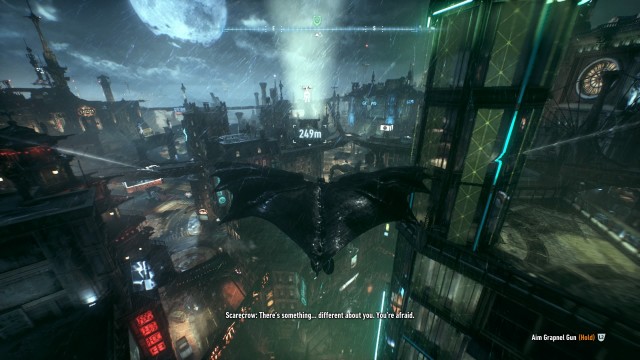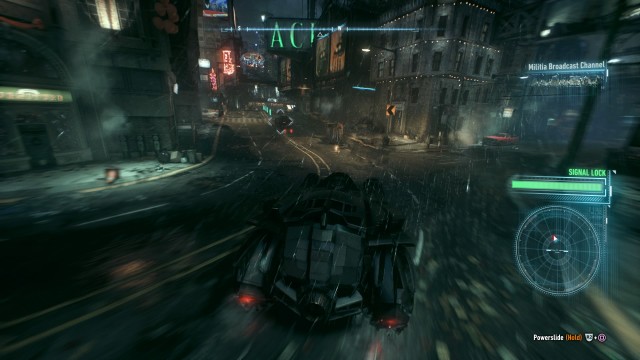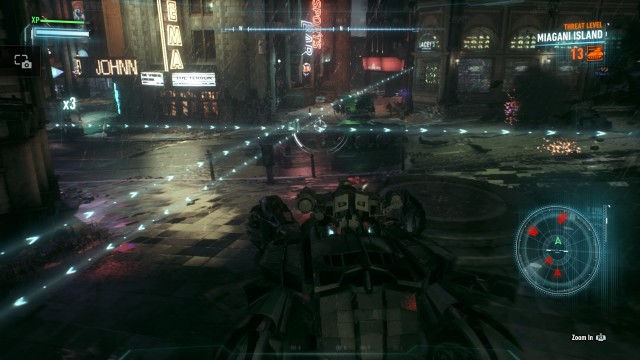
After three games and a handful of titles borrowing its approach to combat and stealth, the “final” game in Rocksteady’s Arkham series is here. Batman: Arkham Knight follows the tradition of the previous games, seeking to expand the scope even more by giving you a handful of new abilities and way to traverse the gigantic city of Gotham.
Taking place on Halloween night several months after the end of Arkham City, Gotham is being terrorized by the return of Scarecrow and his improved fear toxin. As usual, Batman is here to save the day while taking on Scarecrow, a handful of familiar faces and a brand new villain, the titular Arkham Knight, whose goal is simple: kill Batman. The story goes in some interesting and surprisingly dark directions, but it doesn’t do anything to break away from the previous titles’ storytelling formula and as a result becomes a little predictable, at least at first.
Like most popular takes on the Batman character, Arkham Knight focuses on the idea of “Batman,” not just Bruce Wayne as Batman. He’s a symbol of hope in a city surrounded by chaos, a symbol Scarecrow hopes to destroy in the most disturbed ways possible. Again, none of this breaks any new ground, and it never managed to grip me the same way the previous games did. Scarecrow is a one-note villain, the Arkham Knight isn’t imposing so much as whiny and the majority of the returning cast is relegated to side missions.

That is, until the plot starts taking a much darker turn in the second half. The story, while still not entirely unpredictable, managed to surprise me with a few strong moments in particular. It doesn’t help right all of the wrongs of the narrative, but it does help it end on a much stronger note than it began. If you find yourself rolling your eyes at many of the game’s story beats like I did, there’s a good chance the second half of the game will remedy the disappointment.
There is still the matter of some problematic elements, especially the game’s treatment of its female characters. Arkham Knight probably sets some kind of record for the most “women in peril” in a short span of time. This isn’t a particularly shocking thing for comic book stories or even games based on them, but Arkham Knight goes out of its way to remind you that Batman is the hero and everyone else, friend or foe, merely exists to be saved by him. The most troubling is the game’s take on Barbara Gordon, aka Oracle, who starts out strong but is quickly stripped of her agency early on. Just when I thought it was getting better in this regard, it continued to prove me wrong.
It isn’t long after the game’s intro where you are given full control over Batman and are free to roam the city. Like in the previous two Arkham games, the way you traverse Gotham is exciting and allows you to quickly get from one point on the map to another. It’s satisfying in the same way all open-world superhero games should be, as it makes you feel like you are that character. Being able to grapple onto buildings, zoom into the sky and glide across the rain-soaked world with relative ease is exactly what makes this game stand out from many similar superhero titles.

Gliding isn’t the only way to get around Gotham. Arkham Knight introduces the Batmobile, which is both a high-speed vehicle and, with the press of a button, a tank capable of taking down anything that stands in its way. While the conundrum of a “vehicle with guns” in a game starring a character who is opposed to killing is present, Arkham Knight goes out of its way to make sure you know the enemy vehicles you are taking down are unmanned combat drones. See, Batman’s still a good guy.
I rarely found myself using the Batmobile unless it was necessary simply because gliding around the city was more satisfying, but it handles well and is a nice change from your traditional means of transportation. Once you get the hang of the various maneuvers you can pull off, you won’t be nearly as annoyed when the game forces you to drive it to complete an objective. It’s not exactly the game changing addition I expected, but it’s a fun way to add a little of needed variety to a series which desperately needed it.
The downside is the Batmobile’s battle mode, where you find yourself taking down a variety of different (unmanned) vehicles. Think back to Arkham Asylum’s approach to both third-person hand-to-hand combat and stealth and just how groundbreaking it was at the time. Arkham Knight’s take on vehicular combat, on the other hand, is rote. It boils down to this: you move around in battle mode, take shots at the other vehicles when your weapon is ready and avoid their easily avoidable gunfire. They try to change things up later on by adding vehicle stealth (yes, vehicle stealth), but this is more tedious than exciting.

Once you’re out of the Batmobile, you’ll find it’s the same Batman experience you’re used to. Despite this being the fourth game in the series, the combat is still just as satisfying as it was back in 2009, such as the fluid movement from one enemy to another, pulling off easy combos and counters and mixing traditional fighting with various gadgets to assist in the battle.
Right from the start, the game throws a handful of new enemies your way which force you to actually pay careful attention when you fight. For example, medics can not only bring back downed enemies, they can electrify the armor of their allies, which makes it impossible to attack or counter them for a short period of time. The various enemy types being thrown into the mix isn’t new, but the variety of combat scenarios you’ll find yourself in has increased, giving you reason to be more careful when you are executing your various attacks. I found myself relying more on gadgets and new moves, such as a counter which knocks an opponent away from the larger group, than in previous games.
The stealth sections have remained relatively unchanged, but the environments you find yourself in allow for a few new approaches. The biggest change is the addition of the “fear” attack, which allows you to sneak up on a group of enemies and quickly dispatch them with relative ease. Since the maps you find yourself in are more open and the groups you’re dealing with are much larger than previous games, this is a great way to encourage grouping enemies together rather than spreading them apart, changing the fundamentals of the Batman stealth experience altogether. It’s a smart change which successfully blends together with the elements the player has already mastered.

It wouldn’t be an open-world game without a handful of side missions to complete. Some of these aren’t particularly exciting, including disarming bombs using the Batmobile, taking down enemy-infested watch towers and rescuing various civilians, but there are a few which involve returning faces. You’ll find yourself taking on the likes of Penguin, Two-Face and Firefly, among others, in their own side stories which involve them taking advantage of the chaos spreading through Gotham. The structure of the missions is handled better than in Arkham City and Origins, offering you a little more control over which missions you focus on next.
My favorite of the bunch were the Two-Face missions, where you have a set amount of time to stealthily take down his gang attempting to rob a bank. These missions start small, but the scale quickly, as well as the variety of enemies, increases drastically. With each new mission, you were met with a larger environment and even more ways to approach the situation.
The Riddler is also back, as you might expect, but his challenges are a little different this time around. Because it’s the big new gameplay feature in Arkham Knight, The Riddler has set up a series of Batmobile time trials for you to complete alongside some other vehicle-focused puzzle rooms. These challenges are probably the weakest side missions in the game as they focus less on demonstrating your abilities and more on trial-and-error, which quickly becomes tiresome.

Thanks to the power of new hardware, there are impressive graphical enhancements which help Arkham Knight stand out among even the best looking open-world titles around. It’s a gorgeous game, with the enhanced visuals bringing Batman’s world to life in full gritty details. Whether you are gliding across the rain-soaked rooftops or speeding through the chaotic streets in the Batmobile, it’s a stunning title that clearly utilizes the power of these new consoles as much as possible.
As you’ve come to expect from Rocksteady, Batman: Arkham Knight is another great title in a series full of them. The story is problematic and the addition of the Batmobile is both a blessing and a curse, yet Arkham Knight still manages to impress on many levels. Even if it’s not the breath of fresh air Arkham Asylym was, it still manages to impress. If this truly is Rocksteady’s final Batman game, then the team is going out on a high note.
Pros: Stunning visuals, Batmobile adds some nice variety, small-yet-important gameplay improvements
Cons: Story features problematic elements, Batmobile combat is tedious



















